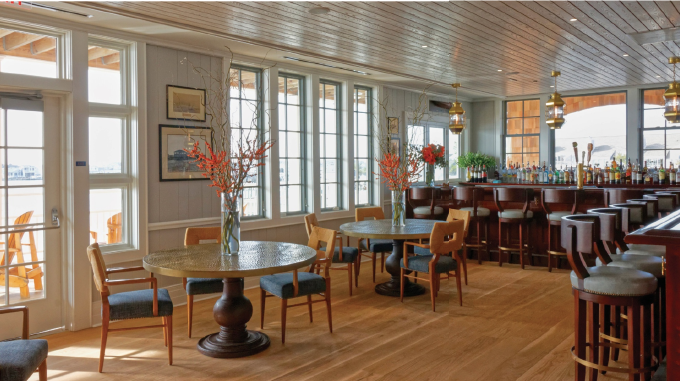The Bay Head Yacht Club in New Jersey was established on September 8, 1888 “to promote yachting and rowing and to foster athletic sports upon the water.”
Bay Head was then emerging as a popular seaside resort that attracted prominent families from Philadelphia and New York. The first clubhouse was built in 188 on pilings at the head of Barnegat Bay. The modest building was surrounded by marshes and reached from land by boardwalks .In 1893 the clubhouse was moved 100 yards east to its present location and in 1928 the current clubhouse was built to accommodate a growing membership.
Bay Head Yacht Club’s campus is a key site in Bay Head’s historic district.
It includes two buildings separately listed on the National Register as “contributing structures” within the historic district: the clubhouse and the boat shed, formerly known as Dale’s Yacht Basin, on Lake Avenue.During Superstorm Sandy, the yacht club suffered significant damage. Following minor repairs, a renovation and restoration of the 26,000 square foot clubhouse was planned. Architectural work for the renovation was commissioned to Platt Byard Dovel! White Architects of New York City. Architectural woodwork for the public spaces was fabricated and installed by American Millwork and Cabinetry, an AWi member firm located in Emmaus, Pennsylvania. The $700,000 project was finished in the spring of 2015.
Renovations
Primary design considerations says Samuel White FA IA, partner in charge of PBDW Architects, the clubhouse needed to look good enough to satisfy long term dues-paying members with many fond memories of the building. It also had to meet a very tight budget and schedule and “achieve an institution a level of quality.” The aesthetic, he explains, is “seaside colonial revival. We used a lot of beadboard and standard moulding profiles and in a few places we used clear finished woods to replicate the bright work on a boat.” The custom Commodore bar is Mahogany while the tongue and groove ceiling is Ash.
Woodwork elements for the clubhouse included the bar and back counter for the Barnegat Room, the bar in the Commodore Room, tongue and groove ceiling in the Commodore Room, a slat ceiling in the entry hall and acoustical Walnut veneer ceiling in the Barnegat Room.
George Reitz of AmericanWoodwork and Cabinetry reports the firm also did wainscot paneling, column surrounds. coffers. base trim. chair rail and crown mouldings. plus glass trophy cases with doors and storage. Poplar was used and painted in many areas. The ceilings were highlighted with finished woodwork. Mahogany was stained and finished with clear lacquer was used on the Commodore Bar while the ceiling in that room was Ash. Red Oak was used in the Barnegat Bar, with Walnut veneer on the ceiling.
The Challenges
feet higher. raise the building, resettle it on its foundations, and then finish the interior.” The schedule for finishing the interiors was also a challenge, he goes on to say. “We had to perform a huge amount of work before we could resettle the building on the new foundations, and we could only close the clubhouse for one summer.” Especially noteworthy to Reitz were the display cases between the dining area and entry hall, including the walk through entry, which were fully prefabricated at the woodworking plant. ‘The entire floor to ceiling assembly was built in sections and shipped to the site. They feature Poplar framed locking glass doors and storage behind beadboard doors on the dining room side. They had to be built around existing structural columns.”
As far as technical assistance was concerned, he continues,American Millwork and Cabinetry “took the presented renderings and design drawings to an engineered reality, by figuring out all the materials and joinery to accomplish what the customer. architect and designer wanted to see in the final product.” “Our working relationship with PBDW was excellent. We were able to handle the changes. site conditions. and revisions with ease. Communication was good and they were very pleasant to deal with on a daily basis.”
‘We pride ourselves on producing old world craftsmanship products using today’s new world technology. We will produce your project conforming to the highest of quality standards.’
-George Reitz, President
VIEW DESIGN SOLUTIONS MAGAZINE


